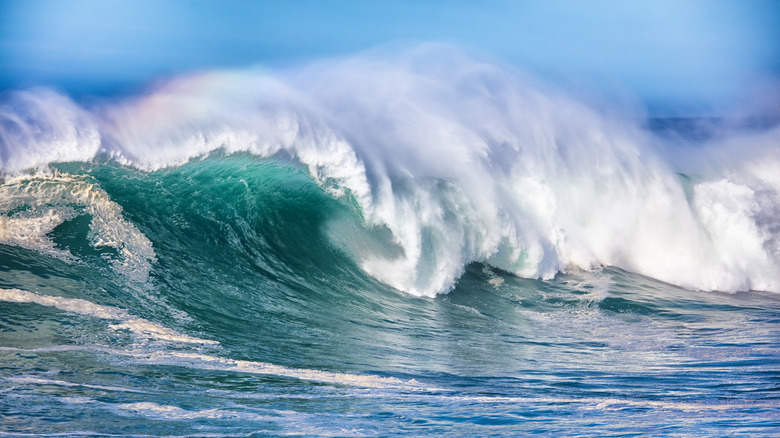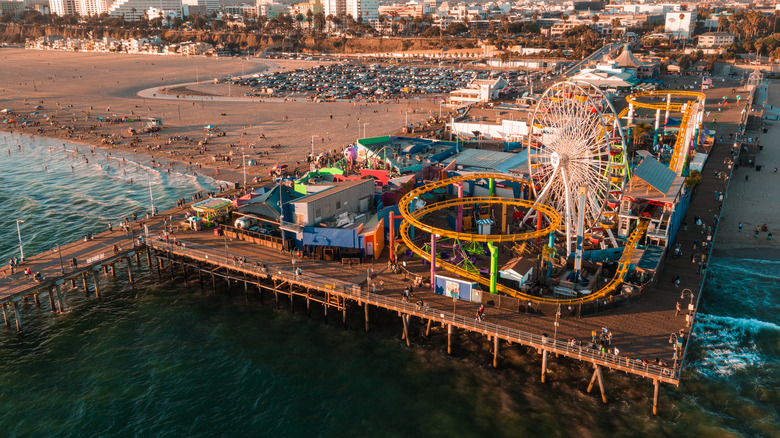The Unpleasing Way That California's Ocean Waters Differ From Others
California is renowned for its outstanding weather. This is especially true for the Golden State's coast, which covers 840 miles. So it's no wonder that Californians are said to be living in an endless summer. Nevertheless, beachgoers are in for a surprise when they step foot into the Pacific Ocean. The water may look inviting, especially on a sunny day. However, regardless of the season, the ocean is exceptionally chilly. Rarely does the water temperature climb above 70 degrees Fahrenheit. Notably, temperatures throughout the year typically range from the 50s to 60s.
In comparison, Florida and Hawaii, popular beach destinations in the country, have warm year-round water temperatures in the 70s and 80s. In the summer, the water in Florida can even reach over 100 degrees Fahrenheit. If you're wondering why there is such a stark difference in temperatures in the sea and on land in California, there is, of course, a scientific explanation. The crisp seawater is a result of several factors, including the California Current, which carries chilly Alaskan waters down to California's coast.
Then there's coastal upwelling. This is when wind, aided by Earth's rotation, brings in cold water from beneath the ocean. This is also what leads to California's notorious "June Gloom," when cloud cover and fog are more common. So California's weather is not so perfect after all, and some beaches have been known to have exceptionally frigid ocean water.
California destinations with unusually chilly ocean temps
Located in San Diego County, Del Mar is an upscale coastal town with luxurious resorts and breathtaking landscapes. It's home to Del Mar City Beach and North Beach, also referred to as Del Mar Dog Beach because it's animal-friendly. It's about 20 minutes from La Jolla Cove, acclaimed for its unmatched beauty and for being one of the most photographed beaches in California. However, in early April 2023, Del Mar made headlines for its unusually cold ocean water that clocked in at 52.25 degrees Fahrenheit, lower than its usual high 50s or low 60s that time of year.
Lyall Bellquist, a scientist at the Nature Conservancy, blamed global warming for this alarming water temperature in an interview with Fox 5. "When people think about climate change, they think about gradual warming temperatures." Bellquist continued, "But what else comes with climate change is increased variability. And when you have more variable temperatures, you have more extremes happening more often."
Bodega Bay, near San Francisco, is another destination experiencing even lower-than-usual temperatures. In June 2022, the water on the shores of this popular coastal camping spot was just 47.8 degrees Fahrenheit. Although this may be unpleasant for beachgoers, there is an upside: A Cal Poly study found upwelling combats the negative effects of climate change. Drastic temperature spikes can harm marine ecosystems, but upwelling prevents marine life along the California coast from experiencing damaging heat waves such as those happening in Florida and other parts of the world.
California's beaches are also infamously dirty
If you're visiting California soon and are planning to swim at the beach, pack accordingly to prevent feeling chilly. For instance, bring a sweater and a change of clothes so you don't have to stay in a cold, wet bathing suit all day. If you are especially averse to cold water temperatures, consider purchasing a wetsuit. Although a typical wetsuit has long sleeves and covers the legs for optimal heat conservation, another option is a shorty wetsuit. It has short sleeves and covers your legs to just above the knee. Of course, you can always check out one of the best beaches in California for a perfect late-night summer bonfire to stay warm.
But alas, cold water is not the only thing California beachgoers have to worry about. The beaches are notoriously polluted. In 2023, Santa Monica Pier, one of the most famous beaches in the world, topped Heal the Bay's Beach Bummer list in its annual beach report card. It received an F grade, tied with Playa Blanca in Baja California. Simply put, the nonprofit concluded that the Santa Monica Pier had the most contaminated water out of 700 beaches.
This is said to be caused by stormwater runoff and could potentially be harmful to unsuspecting beachgoers. Other California beaches that were featured on the Beach Bummer list include Mother's Beach in Marina Del Rey and Linda Mar Beach, also referred to as Pacifica State Beach, in Pacifica.


